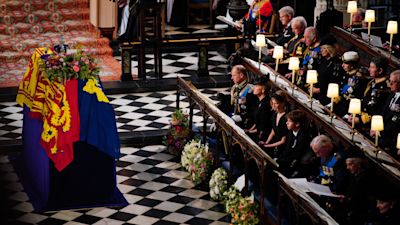Royal family begins week of mourning after the Queen's funeral

The royal family is observing another week of mourning for the Queen after a state funeral full of emotion and ceremony under the gaze of the world.
King Charles III decreed on September 9, the day after the Queen died following her 70-year reign, that a period of mourning would be observed until seven days after the funeral.
Buckingham Palace said: “Following the death of Her Majesty the Queen, it is His Majesty the King’s wish that a period of royal mourning be observed from now until seven days after the Queen’s Funeral.
“Royal mourning will be observed by members of the royal family, Royal Household staff and representatives of the Royal Household on official duties, together with troops committed to ceremonial duties.”
The family members are not expected to carry out official engagements, and flags at royal residences will remain at half-mast until 8am after the final day of royal mourning.
They have been left bereft by the death of their mother, grandmother and great-grandmother, and at times their grief was palpable with Charles looking emotional at the state funeral.
The Countess of Wessex was also seen weeping during the long day as was the Duchess of Sussex, who returned with the Duke of Sussex to the royal family to share their grief.
But Charles and his family have been consoled by the support and love they have received from the public, including the tens of thousands who turned out to watch the late monarch’s funeral procession make its slow journey through the capital and on to Windsor Castle for the committal service.
The Queen was finally laid to rest with her husband the Duke of Edinburgh during a private evening burial service attended just by close family.
The family’s website said it was conducted by the Dean of Windsor, adding: "The Queen was buried together with The Duke of Edinburgh, at The King George VI Memorial Chapel.”
The royal Twitter account published a picture of the Queen taken at Balmoral in 1971, with the words: “May flights of Angels sing thee to thy rest. In loving memory of Her Majesty The Queen.”
The quote is from Shakespeare’s Hamlet, and was said by Charles in his speech to MPs and peers on September 12.
The words are said by Horatio as he pays tribute to his dying friend Hamlet in the tragedy.
The day of the funeral was filled with personal touches, with the wreath adorning the Queen’s coffin featuring a handwritten note from the King, saying: “In loving and devoted memory. Charles R.”
Charles had requested the floral tribute which replaced a wreath of Balmoral flowers with foliage and blooms cut from the gardens of Buckingham Palace, Clarence House and Highgrove.
The simple committal service at St George’s Chapel contrasted with the earlier state funeral, with the Queen’s close staff represented, including her senior dresser and personal adviser Angela Kelly, alongside individuals like Earl Spencer, the brother of Diana, Princess of Wales.
It was heavy with symbolism with the Camp Colour from the military unit personally commanded by the Queen – Queen’s Company, 1st Battalion Grenadier Guards – placed on her coffin by the King.
Baron Parker – the Lord Chamberlain and a former MI5 chief, and the most senior official in her royal household – “broke” his wand of office by dismantling it into two halves and laying them on her coffin.
As the committal service drew to a close the sovereign’s piper, Pipe Major Paul Burns played a lament and walked away from the congregation, his tune fading into the chapel air.
Earlier in the day, the state funeral at Westminster Abbey was attended by dignitaries including hundreds of heads of state, and with London full with mourners the event called for the largest policing operation undertaken by the Metropolitan Police.
Among the 2,000-strong congregation at the abbey were foreign royalty, leading figures from UK life and world leaders including US President Joe Biden and French President Emmanuel Macron.
During his sermon, the Archbishop of Canterbury told the congregation the outpouring of emotion for the Queen “arises from her abundant life and loving service, now gone from us”.
Justin Welby described the Queen as having touched “a multitude of lives” and being a “joyful” figure for many.
The remarkable life of the Queen remembered in our latest episode of What You Need To Know.